

Triple Aim for Populations. Our goal: Drive the Triple Aim, simultaneously improving the health of the population, enhancing the experience and outcomes of the patient, and reducing per capita cost of care for the benefit of communities.
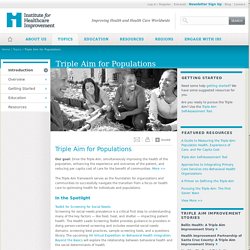
More >> The Triple Aim framework serves as the foundation for organizations and communities to successfully navigate the transition from a focus on health care to optimizing health for individuals and populations. In the Spotlight Toolkit for Screening for Social NeedsScreening for social needs prevalence is a critical first step to understanding many of the key factors — like food, heat, and shelter — impacting patient health. The Health Leads Screening Toolkit provides guidance to providers in doing person-centered screening and includes essential social needs domains, screening best practices, sample screening tools, and a questions library. Do Small Physician Practices Have a Future? IHI Global Trigger Tool for Measuring Adverse Events (Second Edition) How to cite this paper: Griffin FA, Resar RK.
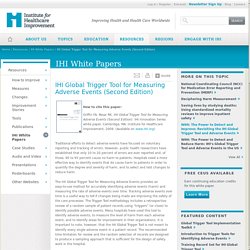
IHI Global Trigger Tool for Measuring Adverse Events (Second Edition). IHI Innovation Series white paper. Cambridge, MA: Institute for Healthcare Improvement; 2009. What can mental health services learn from the automotive industry? What do mental health services and the automotive industry have in common?
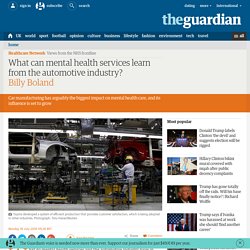
You would be forgiven for thinking “not a lot” on the face of it, but they are moving ever closer together. We in mental health have been looking at business practices from outside our field that improve services for the benefit of patients, carers and staff alike. While car manufacturing may not appear an obvious starting point, it has arguably had the biggest impact so far, and its influence is set to grow. From a UK perspective, the journey began in Japan and came via the US. Toyota developed their process of making cars that is now known as the lean manufacturing system. 3 Expert Tips on How to Grab Attention With Your Data Visualizations. The moment you glanced at this post, you were judging it.

Before you were even aware of it, you were judging how long it seemed, what colors are visible on the page and in the images, whether or not the visuals prompted any emotional response, etc. No matter who you are and whether or not you’re aware of it, every single time you’re presented a visual scene – whether looking at a web page, walking into a room or turning on your television, you start to make sense of that visual experience within 1/10th of a second. This is referred to as “pre-attentive processing” – you process visuals literally before you’re paying attention to them.
The Management Thinker We Should Never Have Forgotten. Gothenberg, Sweden, is a long way to travel from Boston for a breakthrough idea in management — especially one that is more than 40 years old.

I made the journey to attend a health care confab where Don Berwick, the former head of the Institute for Healthcare Improvement, based in Cambridge, Massachusetts, was delivering the opening lecture. Berwick’s talk began by deftly comparing Frederick Winslow Taylor and W. Edwards Deming: the former an industrialist who equated machines and human beings (both to be managed for maximum output), the latter a humanist who saw the individual as internally motivated to do good, meaningful work. Personality styles, types, theories and psychometrics models, personality tests and quizzes theory. Personality models on this page The Four Temperaments/Four Humours Carl Jung's Psychological Types Myers Briggs® personality types theory (MBTI® model) Keirsey's personality types theory (Temperament Sorter model) Hans Eysenck's personality types theory Katherine Benziger's Brain Type theory.
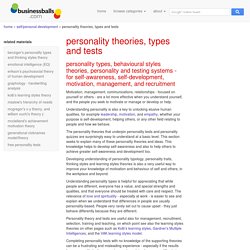
Big Five Personality Traits Model - Career Tests From MindTools.com. Comparing Personalities with Roles © iStockphotoplrang Measure the five key dimensions of your personality.

Have you ever worked in a job that just didn't fit with your personality? Nudge Theory explanation. 'Nudge' theory was proposed originally in US 'behavioral economics', but it can be adapted and applied much more widely for enabling and encouraging change in people, groups, or yourself.
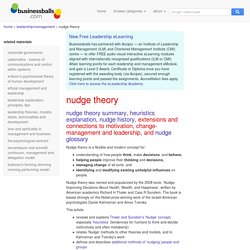
Nudge theory can also be used to explore, understand, and explain existing influences on how people behave, especially influences which are unhelpful, with a view to removing or altering them. There are lots of these unhelpful 'nudges' everywhere - notably in advertising and government; some accidental, many very deliberate. Note: This article is not a reproduction or extraction of Thaler and Sunstein's work - it is a summary, interpretation and extension 'Nudge' theory, including the main terminology, expanded by supplementary methods, with helpful explanations, examples and connections, to related ideas and concepts of motivation and management. index - nudge theory basic index 1. 2. 3. 4. 5. 6. 7. 8. 9.
Cultivating a Creative Mindset. 28 9Share.

The Creative Thinking Myth. The Creative Thinking Myth. Blog - Tracking Wonder. I want to address specifically misconceptions about first books, specifically the first novel.
There are two schools of thought on first novels. Some people believe your first novel is essentially practice. Psychology Of Creativity - London IA 30.03.10. Heuristics of DirectedCreativity. Heuristic: A rule of thumb that often helps in solving a certain class of problems, but makes no guarantees. Example of a heuristic in business: “What gets measured gets done.” This is useful advice in that it points us in a potentially productive direction. WIHI Archive. Welcome to WIHI. WIHI is an exciting "talk show" program from IHI, originally envisioned by Don Berwick, MD, former President and CEO, Institute for Healthcare Improvement. (Currently President Emeritus and Senior Fellow at IHI). You can watch Don talk about WIHI in the video below.
WIHI is free, it’s timely, and it’s designed to help dedicated legions of health and health care improvers worldwide keep up with some of the freshest and most robust thinking and strategies for improving health and patient care. The quality improvement movement has reached a tipping point in terms of global reach, provider and payer consciousness, and bold new ideas for health care reform. The opportunity to influence and shape what fundamental change looks like has never been greater. The issues may be complex, but the format of WIHI is simple.
Rediscovering Passion In Healthcare. NHS IQ. More information about the QSIR programme The Quality, Service Improvement and Redesign (QSIR) programme has met the required standards for the Institute of Healthcare Management (IHM) professional accreditation. Spread across seven months, the programme consists of five one-day workshops and a closing knowledge exchange event and is suited to both clinical and non-clinical staff involved in service improvement projects within their organisation and/or system. Based upon previous highly successful programmes, it covers tried and tested approaches, tools and techniques. Our aim is to provide the highest quality mental health and community care in England. Object moved. IHI Home Page.